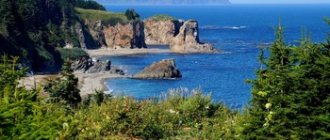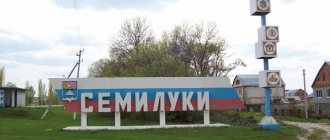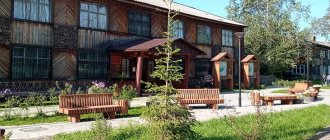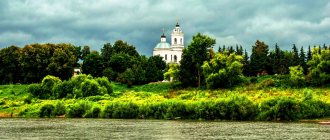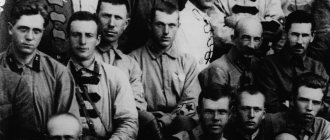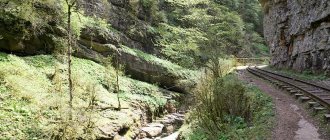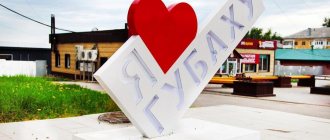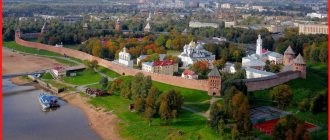On the shores of Aniva Bay is located one of the most attractive cities for tourists in the southern part of the island - Korsakov. Its history dates back to 1853, where the first Russian settlement on Sakhalin was located on the site of the current city. It was called the Muravyovsky post - in honor of the Governor-General of Eastern Siberia Nikolai Muravyov. Soon the post was renamed Korsakovsky - in honor of another East Siberian governor-general, Mikhail Korsakov. And after the end of the Great Patriotic War, the city acquired its modern name. SakhalinMedia news agency invites readers to immerse themselves in the history of the city and learn about the most attractive attractions that are worth visiting.
Yuzhno-Sakhalinskaya street
The entrance to Korsakov is located in the north of the city, which starts from Yuzhno-Sakhalinskaya Street, it is a cultural heritage site. Once upon a time it was the main street of the Korsakovsky post. Yuzhno-Sakhalinskaya abuts the seashore, where you can see a large number of port buildings, ships moored and the endless blue sea.
The first streets of Korsakov and convicts. Photo: I. Pavlovsky, project oldsakhalin.ru
The legendary "Novik"
Noviks were young people from the nobility who entered the higher naval military schools of the Russian Empire to study. “Novik” was the name given to a brand new cruiser - beautiful, elegant, fast - the pride of the Russian fleet, which terrified the enemies of the Fatherland, becoming a legend of Russian history along with its entire crew. Here, on the roadstead of the Korsakov post, on August 7, 1904 (August 20, new style), the 2nd rank cruiser Novik took its last battle with the Japanese and was scuttled by order of the ship’s commander, so as not to be captured by the ships of the Japanese squadron pursuing the cruiser from the shores Port Arthur. “Novik” managed to break the blockade of Port Arthur, was able to escape pursuit, preserved the honor and dignity of the Russian flag, fighting and after its death, the guns carried by the crew from the ship to the shore. Then the ship’s crew and the residents of the Korsakovsky post said goodbye to the legend of the Russian fleet. This sad event became a harbinger of changes in their lives and in the life of their city. Korsakovites learned about the Port Arthur tragedy from the stories of Novikovites.
Memorial sign at the site of the founding of the Muravyovsky post
A memorial sign at the site of the founding of the Muravyovsky post, which later became the city of Korsakov, was unveiled on October 2, 2003. It was here in 1853 that Admiral Gennady Ivanovich Nevelskoy founded the Muravyovsky post, named after the Governor-General of Eastern Siberia Nikolai Nikolayevich Muravyov. The monument is located on a hill, behind the intersection of Okruzhnaya and Vokzalnaya streets. There is no convenient path to it, but if you wish, you can climb the hill. An interesting fact is that the townspeople installed this sign themselves, without the help of the authorities, in memory of their ancestors. On the side of the arch facing the sea, there is a slab with the inscription “... I, the undersigned, the head of this region, on September 22, 1853, at the main point of the island of Sakhalin, Tomari-Aniva, set up the Russian Muravyovsky post ... Gennady Nevelskoy,” as it says in the modern guidebook “ Sakhalin and the Kuril Islands"*.
A memorial sign at the site of the founding of the Muravyovsky post. Photo: pravosakh.ru
City leaders
Chairmen of executive committees[4]:
- Volkov, Viktor Stepanovich - in 1947
- Svetovidov, Ivan Iudovich - in 1947
- Maklakov, Ivan Vasilievich - from December 26, 1947 to 1950
- Moiseenko, Sergei Yakovlevich - from 1950 to 1952
- Snegirev, Kuzma Vasilievich - in 1953
- Talagaev, Ivan Vasilievich - from 1953 to 1955
- Agapova, Anastasia Mikhailovna - from 1955 to 1956
- Koryakin, Alexander Semenovich - from 1956 to 1957
- Chelyadinov, Alexander Tikhonovich - from 1957 to 1958
- Zolin, Alexander Alexandrovich - from 1958 to 1960
- Sizov, Nikolai Pavlovich - from 1960 to 1961
- Gridyaev, Nikolai Vasilievich - from 1961 to 1966
- Paramonov, Alexander Dmitrievich - from 1966 to 1967
- Polikarpov, Vladimir Alexandrovich - from 1967 to 1969
- Dolgikh, Ivan Mikhailovich - from 1969 to 1972
- Kholodenov, Nikolai Petrovich - from 1972 to 1973
- Noskov, Vitaly Vitalievich - from 1973 to 1975
- Aldoshin, Vitaly Tikhonovich - from 1975 to 1978
- Chernyshov, Mikhail Petrovich - from 1979 to 1980
- Danilov, Viktor Ivanovich - from 1980 to 1986
- Semenozhenko, Vasily Vasilievich (born 1945) - from 1986 to 1990
- Morozov, Gennady Yakovlevich (born 1942) - in 1990
- Timofeev, Valerian Aleksandrovich (born 1940) - from 1990 to 1991
Railway station building
The building is located on Vokzalnaya Street. Korsakov station was opened on June 1, 1908 as part of the railway of the Karafuto governorate, and was included in the Soviet railways on April 1, 1946.
Old Japanese railway station building. Photo: Collection of the Sapporo City Library, project oldsakhalin.ru
Attractions[edit]
Facilities include a rather seedy and expensive hotel (Alpha) next to the former park. The beach is easily accessible by car (Okhotsk, about 1 hour, Prigorodnoye, about 30 minutes). The previously well-groomed beach on Second Pad has turned into a dirty dump.
Winter attractions include ice skating at the town stadium and excellent cross-country skiing past the former seaweed factory (Na Agarike). There are no conditions for alpine skiing.
The city has a museum with an exhibit about the history of the local borderland and Japanese ownership of the city (1905–1945). The local market on Sovetskaya Street offers excellent strawberries in the summer and well-prepared Korean delicacies (kimchi and the local hit, fern, all year round).
Korsakov Map
Foreign tourists from certain countries transiting by cruise ship or by air can now visit the city without a visa for 72 hours. [22] [23]
Observation deck
To get to the site you need to move along Krasnoflotskaya and turn onto Dachnaya Street. From the top you can see a breathtaking view of Aniva Bay, you can see ships in the roadstead, the work of the port, coastal cliffs and hills, and Korsakov itself. The best time to view many of the beauties from the observation deck is sunset, when the port lights up. New benches have been installed on the site where you can sit and admire the picturesque views. There is a military unit nearby; through its mesh fence you can see neatly arranged military equipment.
View of the port from the observation deck. Photo: vk.com
Transport[edit]
Korsakov is located approximately 30 km from Yuzhno-Sakhalinsk Airport. Regular buses and minibuses connect Korsakov with the capital Yuzhno-Sakhalinsk, but not with the airport. Passenger ferry service between Korsakov and Wakkanai, Hokkaido, Japan, via Aniva Bay was restored in 2016 and operates from June to September each year. Passenger ferries are operated by the Commonwealth of Dominica-flagged Penguin 33, which is a high-speed vessel owned by Penguin International Limited, a Singapore-based public company. [24] [25]
The Japan National Railway Passenger Ferry Service previously operated a ferry service from Wakkanai called "Chihaku-Renrakusen (Chihaku Ferry Service)" from 1923 to 1945, which was connected to the Japan National Rail Network and Yuzhno-Sakhalinsk (then called Toyohara). The old Japanese narrow gauge railway still runs along the picturesque coastline, with occasional rail connections.
There are several bus routes serving urban areas and a number of villages in the immediate area.
The city has a large seaport.
Marine Station
This is the largest port in the Far Eastern basin, operations are carried out year-round. The port transships timber cargo, coal, crude oil and petroleum products, metal and scrap metal, equipment, containers, and general cargo. Repairs ships, extracts and processes fish and seafood, carries out passenger transportation on the Sakhalin-Kuril, Wakkanai (Japan)-Korsakov and Vladivostok-Korsakov ferry lines
The port of Korsakov was founded in 1853 by the expedition of Gennady Nevelsky as the military post “Muravyevsky”.
Recently, Korsakov has been extended a free port regime, that is, foreign citizens and stateless persons arriving in Russia for tourism purposes on ferries are allowed to enter the Russian Federation through it.
Sea port. Photo: Yuri Gurshal, SakhalinMedia news agency
Politics[edit]
The city has an executive branch (mayor's office or "municipal administration") and a legislative branch (Duma). In practice, the Duma has rather limited influence on the executive branch.
List of mayors:
- Lada Mudrova (since 2008)
- Gennady Zlivko (2004–2008): removed by court decision.
- Alexander Svoyakov (acting): lost in the elections to Gennady Zlivko
- Valery Osadchiy (1993–2004): resigned.
- Yuri Savenko (1991–1993): resigned.
Monument to "Divided Families"
Opposite the sea station, there is a hill that is popularly called the Mountain of Tears and Sadness, on which an unusual, charming and, in its way, sad Monument of “Separated Families” is installed. After the end of the war, about 40 thousand Korean workers, brought to the island during Japanese rule in southern Sakhalin, gathered here every day. They peered into the surface of the sea, dreaming of sailing to their homeland, to their families. Japan hastily took away its subjects, but refused to take away the Koreans. The Republic of Korea was able to send only three ships to the Sakhalin shores, which could not accommodate all those in need. Since then, many Koreans have forever lost the opportunity to see their family and friends.
The monument was erected in 2007. Fundraising for the construction of the memorial took place both in the Republic of Korea and on Sakhalin. The monument was created by the world-famous avant-garde sculptor Choi In-soo, and the poems that are carved on the pedestal were written by Kim Moon-hwan, the author of the anthem of the 1988 Seoul Olympic Games. According to the president of the Hangan Forum organization, the monument on Mount Sadness should not only remind of the tragedy, but also make one think about the future, about relations between countries that will not allow what happened many years ago to happen again.
Monument to "Divided Families". Photo: tripadvisor.ru
Monument to "Divided Families". Photo: vk.com
1
/ 2
An excerpt characterizing Korsakov (city)
– Andre, si vous avez. la foi, vous vous seriez adresse a Dieu, pour qu'il vous donne l'amour, que vous ne sentez pas et votre priere aurait ete exaucee. [If you had faith, you would turn to God with a prayer, so that He would give you the love that you do not feel, and your prayer would be heard.] - Yes, is that so! - said Prince Andrei. - Go, Masha, I’ll be right there. On the way to his sister’s room, in the gallery connecting one house to another, Prince Andrei met the sweetly smiling Mlle Bourienne, who for the third time that day had come across him with an enthusiastic and naive smile in secluded passages. - Ah! “je vous croyais chez vous, [Oh, I thought you were at home,” she said, for some reason blushing and lowering her eyes. Prince Andrei looked at her sternly. Prince Andrei’s face suddenly expressed anger. He said nothing to her, but looked at her forehead and hair, without looking into her eyes, so contemptuously that the Frenchwoman blushed and left without saying anything. When he approached his sister’s room, the princess had already woken up, and her cheerful voice, hurrying one word after another, was heard from the open door. She spoke as if, after a long abstinence, she wanted to make up for lost time. – Non, mais figurez vous, la vieille comtesse Zouboff avec de fausses boucles et la bouche pleine de fausses dents, comme si elle voulait defier les annees... [No, imagine old Countess Zubova, with false curls, with false teeth, like as if mocking the years...] Xa, xa, xa, Marieie! Prince Andrei had already heard exactly the same phrase about Countess Zubova and the same laugh five times in front of strangers from his wife. He quietly entered the room. The princess, plump, rosy-cheeked, with work in her hands, sat on an armchair and talked incessantly, going over St. Petersburg memories and even phrases. Prince Andrei came up, stroked her head and asked if she had rested from the road. She answered and continued the same conversation. Six of the strollers stood at the entrance. It was a dark autumn night outside. The coachman did not see the pole of the carriage. People with lanterns were bustling about on the porch. The huge house glowed with lights through its large windows. The hall was crowded with courtiers who wanted to say goodbye to the young prince; All the household were standing in the hall: Mikhail Ivanovich, m lle Bourienne, Princess Marya and the princess. Prince Andrei was called into his father’s office, who wanted to say goodbye to him privately. Everyone was waiting for them to come out. When Prince Andrei entered the office, the old prince, wearing old man's glasses and in his white robe, in which he did not receive anyone except his son, was sitting at the table and writing. He looked back. -Are you going? - And he began to write again. - I came to say goodbye. “Kiss here,” he showed his cheek, “thank you, thank you!” - What do you thank me for? “You don’t hold on to a woman’s skirt for not being overdue.” Service comes first. Thank you, thank you! - And he continued to write, so that splashes flew from the crackling pen. - If you need to say something, say it. I can do these two things together,” he added. - About my wife... I’m already ashamed that I’m leaving her in your arms... - Why are you lying? Say what you need. - When it’s time for your wife to give birth, send to Moscow for an obstetrician... So that he is here. The old prince stopped and, as if not understanding, stared with stern eyes at his son. “I know that no one can help unless nature helps,” said Prince Andrei, apparently embarrassed. – I agree that out of a million cases, one is unfortunate, but this is her and my imagination. They told her, she saw it in a dream, and she is afraid. “Hm... hm...” the old prince said to himself, continuing to write. - I'll do it. He drew out the signature, suddenly turned quickly to his son and laughed. - It's bad, huh? - What's bad, father? - Wife! – the old prince said briefly and significantly. “I don’t understand,” said Prince Andrei. “There’s nothing to do, my friend,” said the prince, “they’re all like that, you won’t get married.” Do not be afraid; I won't tell anyone; and you know it yourself. He grabbed his hand with his bony little hand, shook it, looked straight into his son’s face with his quick eyes, which seemed to see right through the man, and laughed again with his cold laugh. The son sighed, admitting with this sigh that his father understood him. The old man, continuing to fold and print letters, with his usual speed, grabbed and threw sealing wax, seal and paper. - What to do? Beautiful! I'll do everything. “Be at peace,” he said abruptly while typing. Andrei was silent: he was both pleased and unpleasant that his father understood him. The old man stood up and handed the letter to his son. “Listen,” he said, “don’t worry about your wife: what can be done will be done.” Now listen: give the letter to Mikhail Ilarionovich. I am writing to tell him to use you in good places and not keep you as an adjutant for a long time: it’s a bad position! Tell him that I remember him and love him. Yes, write how he will receive you. If you are good, serve. Nikolai Andreich Bolkonsky’s son will not serve anyone out of mercy. Well, now come here. He spoke in such a rapid-fire manner that he did not finish half the words, but his son got used to understanding him. He led his son to the bureau, threw back the lid, pulled out the drawer and took out a notebook covered in his large, long and condensed handwriting. “I must die before you.” Know that my notes are here, to be handed over to the Emperor after my death. Now here is a pawn ticket and a letter: this is a prize for the one who writes the history of Suvorov’s wars. Send to the academy. Here are my remarks, after me read for yourself, you will find benefit. Andrei did not tell his father that he would probably live for a long time. He understood that there was no need to say this. “I will do everything, father,” he said. - Well, now goodbye! “He let his son kiss his hand and hugged him. “Remember one thing, Prince Andrei: if they kill you, it will hurt my old man...” He suddenly fell silent and suddenly continued in a loud voice: “and if I find out that you did not behave like the son of Nikolai Bolkonsky, I will be ... ashamed!” – he squealed. “You don’t have to tell me this, father,” the son said, smiling. The old man fell silent. “I also wanted to ask you,” continued Prince Andrey, “if they kill me and if I have a son, do not let him go from you, as I told you yesterday, so that he can grow up with you... please.” - Shouldn’t I give it to my wife? - said the old man and laughed. They stood silently opposite each other. The old man's quick eyes were directly fixed on his son's eyes. Something trembled in the lower part of the old prince’s face. - Goodbye... go! - he suddenly said. - Go! - he shouted in an angry and loud voice, opening the office door. - What is it, what? - asked the princess and princess, seeing Prince Andrei and for a moment the figure of an old man in a white robe, without a wig and wearing old man’s glasses, leaning out for a moment, shouting in an angry voice. Prince Andrei sighed and did not answer. “Well,” he said, turning to his wife. And this “well” sounded like a cold mockery, as if he was saying: “Now do your tricks.” – Andre, deja! [Andrey, already!] - said the little princess, turning pale and looking at her husband with fear. He hugged her. She screamed and fell unconscious on his shoulder. He carefully moved away the shoulder on which she was lying, looked into her face and carefully sat her down on a chair. “Adieu, Marieie, [Goodbye, Masha,”] he said quietly to his sister, kissed her hand in hand and quickly walked out of the room. The princess was lying in a chair, M lle Burien was rubbing her temples. Princess Marya, supporting her daughter-in-law, with tear-stained beautiful eyes, still looked at the door through which Prince Andrei came out, and baptized him. From the office one could hear, like gunshots, the often repeated angry sounds of an old man blowing his nose. As soon as Prince Andrei left, the office door quickly opened and the stern figure of an old man in a white robe looked out. - Left? Well, good! - he said, looking angrily at the emotionless little princess, shook his head reproachfully and slammed the door. In October 1805, Russian troops occupied the villages and towns of the Archduchy of Austria, and more new regiments came from Russia and, burdening the residents with billeting, were stationed at the Braunau fortress. The main apartment of Commander-in-Chief Kutuzov was in Braunau. On October 11, 1805, one of the infantry regiments that had just arrived at Braunau, awaiting inspection by the commander-in-chief, stood half a mile from the city. Despite the non-Russian terrain and situation (orchards, stone fences, tiled roofs, mountains visible in the distance), despite the non-Russian people looking at the soldiers with curiosity, the regiment had exactly the same appearance as any Russian regiment had when preparing for a review somewhere in the middle of Russia. In the evening, on the last march, an order was received that the commander-in-chief would inspect the regiment on the march. Although the words of the order seemed unclear to the regimental commander, and the question arose how to understand the words of the order: in marching uniform or not? In the council of battalion commanders, it was decided to present the regiment in full dress uniform on the grounds that it is always better to bow than not to bow. And the soldiers, after a thirty-mile march, did not sleep a wink, they repaired and cleaned themselves all night; adjutants and company commanders counted and expelled; and by morning the regiment, instead of the sprawling, disorderly crowd that it had been the day before during the last march, represented an orderly mass of 2,000 people, each of whom knew his place, his job, and of whom, on each of them, every button and strap was in its place and sparkled with cleanliness . Not only was the outside in good order, but if the commander-in-chief had wanted to look under the uniforms, he would have seen an equally clean shirt on each one and in each knapsack he would have found the legal number of things, “sweat and soap,” as the soldiers say. There was only one circumstance about which no one could be calm. It was shoes. More than half the people's boots were broken. But this deficiency was not due to the fault of the regimental commander, since, despite repeated demands, the goods were not released to him from the Austrian department, and the regiment traveled a thousand miles. The regimental commander was an elderly, sanguine general with graying eyebrows and sideburns, thick-set and wider from chest to back than from one shoulder to the other. He was wearing a new, brand new uniform with wrinkled folds and thick golden epaulettes, which seemed to lift his fat shoulders upward rather than downward. The regimental commander had the appearance of a man happily performing one of the most solemn affairs of life. He walked in front of the front and, as he walked, trembled at every step, slightly arching his back. It was clear that the regimental commander was admiring his regiment, happy with it, that all his mental strength was occupied only with the regiment; but, despite the fact that his trembling gait seemed to say that, in addition to military interests, the interests of social life and the female sex occupied a significant place in his soul. “Well, Father Mikhailo Mitrich,” he turned to one battalion commander (the battalion commander leaned forward smiling; it was clear that they were happy), “it was a lot of trouble this night.” However, it seems that nothing is wrong, the regiment is not bad... Eh?
Former Japanese bank "Hokkaido Takushoku"
The building of the former Japanese bank was built by the Japanese in the twenties of the last century, when the southern part of Sakhalin was called the “Karafuto Governorate”. It is located on the corner of the city park. The building is designed in a pseudo-classical, simple style with narrow vertical windows. The gable roof of the house was completed in Soviet times, when the building continued to serve as a bank. In the mid-nineties, when a financial institution went bankrupt, the bank fell into disrepair. The building is practically classified as an architectural monument. It is currently under reconstruction.
Japanese bank. Photo: vk.com
Wakkanai Square
It is located a little higher from the bank and was laid out in honor of the Japanese city of Wakkanai, a sister city of Korsakov. There are several interesting monuments in the small park.
In the center there is a monument to Gennady Nevelsky; it is difficult to overestimate his contribution to the study of the island. It was he who proved that Sakhalin is an island, and not a peninsula, as previously thought. The monument was inaugurated in 2013.
In the same park there is also a bust of Mikhail Korsakov, the Governor-General of Eastern Siberia, which is made of bronze and granite. The monument was opened in October 1993. Despite the fact that the city is named after him, Mikhail Semenovich himself has never been here.
There is also a memorial sign dedicated to the 10th anniversary of sister city relations between the cities of Korsakov and Wakkanai.
Wakkanai Square. Photo: tripadvisor.ru
Wakkanai Square. Photo: tripadvisor.ru
1
/ 2
Return
In the chronicles of the city of Korsakov, August 25, 1945 is a special date. On this day, Soviet troops occupied the city of Otomari without a fight or bloodshed: the mayor of the city, avoiding unnecessary casualties among the civilian population, announced the surrender of the city. This event ended the offensive operation of the Soviet troops to liberate Southern Sakhalin. Korsakov gained the right to his historical name, although official recognition occurred a year later. And even though hostilities in the Kuril Islands continued until September 1, it was with the release of Korsakov that Russia regained its right to South Sakhalin.
By decree of the Presidium of the Supreme Soviet of the RSFSR dated June 5, 1946, Otomari was renamed Korsakov, in honor of Mikhail Semenovich Korsakov, and the Russian post officially received the status of a city.
Lenin Square
The square is located in the very center of the city of Korsakov next to the city administration. There is a fountain in the center, around which there are benches and flower beds. Next to the fountain there is a traditional monument to Lenin. However, of greater interest is the monument to those who fell during the liberation of Korsakov from Japanese militarists, erected in 1949, and the memorial sign “300th anniversary of the Russian Fleet” in the form of an anchor, which rests on a stone, installed in 1996.
Not far from the square there is a cinema, a stadium and a cultural center.
Lenin Square. Photo: vk.com
Physical-geographical characteristics
Geographical position
The city is located on the shores of Aniva Bay, 42 km from Yuzhno-Sakhalinsk. Railway station of the Sakhalin region of the Far Eastern Railway.[23]
The Korsakovka River flows through the city.
Climate
The city of Korsakov is equated to the regions of the Far North.
Korsakov is located in the monsoon climate zone. Summers are generally rainy and winters are cold and clear. The warmest month is August, with an average daily temperature of +20.5 °C. The coldest month is January, with an average nighttime temperature of −11.9 °C. The annual precipitation is 700–800 mm. Most precipitation falls from July to October.
| Climate of Korsakov | |||||||||||||
| Index | Jan. | Feb. | March | Apr. | May | June | July | Aug. | Sep. | Oct. | Nov. | Dec. | Year |
| Absolute maximum | 5,4 | 4,8 | 9,7 | 16 | 23,9 | 25,1 | 28,4 | 29,2 | 25,1 | 21 | 14,2 | 8 | 29,2 |
| Average maximum, °C | −5,8 | −5,2 | −1 | 5,1 | 10,5 | 15,6 | 19,4 | 20,5 | 17,1 | 11,2 | 3,4 | −3,2 | 7,4 |
| Average temperature, °C | −8,7 | −8,5 | −4 | 2,3 | 7,3 | 12,1 | 16 | 20,5 | 14,2 | 8,6 | 1 | −5,8 | 4,4 |
| Average minimum, °C | −11,9 | −12,2 | −7,5 | −0,8 | 3,9 | 9 | 13 | 14,6 | 11,4 | 5,8 | −1,5 | −8,6 | 1,3 |
| Absolute minimum, °C | −26,1 | −25,8 | −23,5 | −11,5 | −4,8 | −0,5 | 4,5 | 7,5 | −0,2 | −4,7 | −14,9 | −18 | −26,1 |
| Precipitation rate | 35 | 28 | 37 | 52 | 69 | 65 | 86 | 96 | 101 | 84 | 68 | 46 | 763 |
| Source: [sakhalin-meteo.ru/korsakov/pivot/temperature Meteorological statistics for the Sakhalin region] [www.worldclimate.com/cgi-bin/data.pl?ref=N46E142+2100+3215004G1 World Climate] | |||||||||||||
Radio stations
- Autoradio (Yuzhno-Sakhalinsk, 5 kW) – 531 kHz
- Radio Russia – 72.29 MHz (0.03 kW)
- was Radio Mayak - 73.79 MHz (0.03 kW)
- Retro FM (Yuzhno-Sakhalinsk, 1 kW) – 88.3 MHz
- Radio Record (Yuzhno-Sakhalinsk, 1 kW) – 88.9 MHz
- Russian radio (Yuzhno-Sakhalinsk, 1 kW) – 89.9 MHz
- Traffic radio – 91.2 MHz (0.1 kW)
- Radio Chanson (Yuzhno-Sakhalinsk, 1 kW) – 101.7 MHz
- Radio ASTV – 102.0 MHz (0.2 kW)
- Europe Plus (Yuzhno-Sakhalinsk, 1 kW) – 102.5 MHz
- Humor FM (Yuzhno-Sakhalinsk, 1 kW) – 102.9 MHz
- Radio Mayak (Yuzhno-Sakhalinsk, 5 kW) – 103.5 MHz
- Europe Plus – 104.1 MHz (0.1 kW)
- Love Radio (Yuzhno-Sakhalinsk, 1 kW) – 104.4 MHz
- Radio ASTV (Yuzhno-Sakhalinsk, 1 kW) – 105.5 MHz
- Radio Russia (Yuzhno-Sakhalinsk, 5 kW) – 106.0 MHz
- Road radio (Yuzhno-Sakhalinsk, 1 kW) – 106.5 MHz
- Vesti FM (Yuzhno-Sakhalinsk, 1 kW) – 107.2 MHz
- Radio Russia – 107.6 MHz (0.1 kW)
You can also receive stations from Japan, Korea, Primorye, Khabarovsk Territory
Korsakov Museum of History and Local Lore
The Korsakov Museum of History and Local Lore was opened in 1983, on the 130th anniversary of the city of Korsakov. The museum's exhibitions tell the history of the city and its inhabitants. Materials are presented about the stay of the Russian writer A.P. at the Korsakov post in 1890. Chekhov, who during his trip to Sakhalin conducted a population census, issued cards for prisoners and exiles, and also provided medical assistance, lived in Korsakov for a whole month. The main fund of the museum collections is formed from items donated to the museum by residents and guests of the city. The museum also talks about new technologies for the production of liquefied natural gas, the Karafuto period and the feat of the cruiser "Novik", this is written about in the modern guidebook "Sakhalin and the Kuril Islands "*.
Demographics[edit]
Historical trends of the Korsakov population
| 1959 | 32 900 |
| 1967 | 34 000 |
| 1970 | 38 200 |
| 1979 | 42 300 |
| 1989 | 45 100 |
| 1996 | 40 300 |
| 1998 | 38 300 |
| 2000 | 37 000 |
| 2001 | 36 500 |
| 2003 | 36 700 |
| 2006 | 35 500 |
| 2007 | 35 100 |
| 2008 | 35 000 |
It is curious that at the early stage of settlement (late 1890s) there were almost ten times more men than women in Korsakovsky. For example, in 1897, there were 1,510 men and 192 women living in the city. This imbalance is explained by the fact that the majority of Korsakovites were prisoners and guards - both categories were dominated by men. In the Korsakov region (in 1897, on an area of 66,762 versts), 4,659 men and 2,194 women lived - a much better proportion (without the fort). [19]
The city's population peaked at 45,000 in the late 1980s, after which it declined significantly as residents fled the economic downturn to neighboring Yuzhno-Sakhalinsk or mainland Russia. It is obvious that the population of Korsakov continues to decline, although not as sharply as in the 1990s. [20]
The demographic composition is primarily ethnic Russian with a large ethnic Korean minority.
Monastery of the Intercession of the Blessed Virgin Mary
The monastery was built recently - in 1999. It uses premises that served completely different purposes during the Russo-Japanese War. It is considered the most eastern monastic monastery in Russia.
Until 1904, the building of the Japanese Consulate was located on the site of the monastery, and then - a garrison rest house for Japanese officers. After the liberation of Southern Sakhalin from Japanese militarists in 1945, construction of a military camp began here. During Soviet times, the Sailors' Club, built in 1959, operated on this site. There is very little left of the Japanese consulate, but even this is interesting to take a look at.
The total area occupied by the monastery is 1.792 hectares.
The monastery houses many shrines: icons, relics and even a piece of the vestment of the holy righteous John of Kronstadt.
On the territory of the monastery there is a grave with the burials of Russian sailors from the cruiser Novik who died during the Russo-Japanese War of 1904.
Monastery. Photo: pravosakh.ru
Primate's blessing
Today the monastery is one of the most attractive places in the city; everything related to the history of the place is carefully preserved here. The monastery is constantly being improved.
The monastery is conveniently located on the southern slope of one of the three capes, reliably sheltering it from the cold northern winds. From the territory of the monastery you can see the water surface of Aniva Bay, you can see the water area of the port with its cranes, cargo and passenger ships from all over the world arriving on the island through its sea gate - the port of Korsakov.
The rising sun colors the sea with amazing shades of an incredible palette of colors - from soft pink with tints of golden-scarlet in the morning to purple-red, turning into crimson tones in the evening. Sometimes, through the haze of light clouds, the border separating the turquoise sea and the blue sky is barely visible. This is where the Russian morning begins. From here Russia greets the dawn, turning its prayerful gaze to God. And when on the western borders of the Fatherland the Church is just completing its daily prayer circle, here it already begins again: “From the east of the sun to the west, praise is given to the name of the Lord...”.
His Holiness Patriarch Kirill of Moscow and All Rus' noted in a particularly warm way the significance of the island Korsakov monastery in his Primate Word when visiting the Monastery in 2010. This was the first visit of the First Hierarch of the Russian Orthodox Church in the history of Sakhalin Island, in the history of the city of Korsakov, in the history of the Korsakov monastery. The primate blessing for the monastery was expressed in the words of the Primate of the Russian Church: “The Holy Protection monastery is well known outside of Sakhalin. This is one of the easternmost monasteries of our Church. Here, in the Far East of Rus', you are especially aware of the importance of spiritual outposts, which are the temples of God. This is not the end of the world. This is our Russian land. Here we are at home. This land should not be abandoned, but developed, and I believe that with God’s help this will happen, and life on Sakhalin and throughout our Fatherland will become more and more beautiful.”
The material was published in the special issue of the Foma magazine “Small Towns - Heroes of Russia.” When implementing the project, state support funds are used, allocated as a grant in accordance with the order of the President of the Russian Federation dated April 1, 2015 No. 79-rp and on the basis of a competition held by the Knowledge Society of Russia.
Busse Lagoon
Busse is one of the most popular lakes in the south of the island. The reservoir got its name in honor of Nikolai Busse, a member of the Amur expedition and the first head of Sakhalin Island. The Shishkevich and Arakul rivers flow into the lake, and it also communicates with lakes Chibisansky, Maly and Bolshoy Vavaysky.
Shellfish are also found in the lagoon, mainly mussels, giant oysters, sea scallops, sea cucumbers, and large grass shrimp. The lake is home to many species of fish, including pink salmon, chum salmon, herring, navaga, smelt, crucian carp, taimen and others. Waterfowl nest on the lake. You can also see the Red Book white-tailed eagle, heron, whooper swan, little swan, and Far Eastern curlew.
The red algae Ahnfeltia, from which agar-agar is extracted, is found in abundance.
Busse Lagoon is a natural monument of regional importance and is a rich ecosystem of great commercial and scientific importance.
Catch from Busse Lagoon. Photo: tripadvisor.ru
Busse Lagoon. Photo: tripadvisor.ru
1
/ 2
Lake Tunaicha
Tunaicha is the second largest lake in Sakhalin, salty, lagoon type. The reservoir is conventionally divided into large and small Tunaichu, between which Bird Island is located.
The lake is home to 29 species of fish from 13 families, including 9 species of salmon, including the rare Sakhalin taimen. Chum salmon, pink salmon, herring, smelt and navaga are of commercial importance. A small Tonnai population of Pacific herring breeds and overwinters in the lake. Many species of birds nest along the banks of Tunaichi, including the white-tailed eagle, osprey, mandarin duck, little swan, and whooper swan. Fishing and the use of motorized boats on the lake are limited and regulated. During the licensed hunting season, sport fishing is permitted.
On the coast of Lake Tunaicha there is a burial place of staff captain B. Grotto-Slepikovsky and the fighters of the partisan detachment under his command who died in July 1905. A memorial complex was built here.
Lake Tunaicha. Photo: vk.com
Lake Tunaicha. Photo: vk.com
1
/ 2
Mount Juno
East of the village of Prigorodny there is Mount Juno, named after the ship on which Rezanov traveled. In 1806, this ship, under the command of Nikolai Khvostov, approached the shores of southern Sakhalin.
You can climb the hill at any time of the year. The slopes are quite steep, but even an unprepared person can climb them in a maximum of an hour. It is best to climb from the south side of the mountain. In autumn you can find ripe lingonberries there, and from the top there is a stunning view of the sea, hills and the LNG plant. In 2013, a Memorial Cross was erected here in honor of the Russian pioneers who discovered Sakhalin in 1643, as well as the 160th anniversary of the raising of the Russian flag on the island by the famous navigator Gennady Nevelsky. The installation of the cross required a lot of effort and resources. The cross was lifted to the top of the mountain by a Mi-8 helicopter.
View of the LNG plant from Mount Juno. Photo: Elizaveta Karpova, SakhalinMedia
Commemorative plaque on Mount Juno. Photo: Elizaveta Karpova, SakhalinMedia
Cross on Mount Juno. Photo: Elizaveta Karpova, SakhalinMedia
1
/ 3
Links[edit]
Notes[edit]
- ^ abcde Law No. 25-ZO
- ^ ab Presentation of the project: “Perinatal medicine: positive motherhood” Date: June 1, 2011 Access date: February 4, 2014
- ^ a b Federal State Statistics Service (2011). “All-Russian Population Census 2010. Volume 1" [All-Russian Population Census 2010, vol. 1]. All-Russian Population Census 2010 [All-Russian Population Census 2010]
. Federal State Statistics Service. - "26. The size of the permanent population of the Russian Federation by municipalities as of January 1, 2022". Federal State Statistics Service. Retrieved January 23, 2022.
- ^ abc Law No. 524
- "On the Calculation of Time". Official Internet portal of legal information
. June 3, 2011. Retrieved January 19, 2022. - Post office. Information and computing center of OASU RPO. ( Post office
).
Search for postal service objects ( postal Search for objects
) (in Russian) - Telephone codes of Sakhalin - Telephone codes of Sakhalin Archived December 17, 2022, in the Wayback Machine (in Russian)
- ↑
Federal State Statistics Service of Russia (May 21, 2004).
“The population of Russia, the constituent entities of the Russian Federation as part of federal districts, urban settlements, settlements, settlements of 3 thousand or more people” [Population of Russia, its federal districts, federal districts, districts, urban settlements, rural settlements - administrative centers and rural settlements with a population of more than 3,000 people] (XLS). All-Russian Population Census 2002
. - “All-Union Population Census of 1989. The current population of union and autonomous republics, autonomous regions and districts, territories, negative phenomena, urban settlements and rural district centers” [All-Union Population Census of 1989: current population of union and autonomous republics, Autonomous regions and districts , territories, regions, districts, towns and villages performing the functions of district administrative centers. All-Union Population Census of 1989 [All-Union Population Census of 1989]
.
Institute of Demography of the National Research University: Higher School of Economics [Institute of Demography of the National Research University: Higher School of Economics]. 1989 - via Demoscope Weekly
. - Conquest of the Lands of the Ainu
, Brett L. Walker, ISBN 0-520-24834-1, ISBN 978-0-520-24834-2 - Coast of Kushunkotan archived September 29, 2007 at the Wayback Machine
, 1873 maps. - ^ ab Occupation of Southern Sagalin by Russians in 1853–1854.
, Akizuki Toshiyuki, Hokkaido University. - 久春古丹に於ける露人の堡塞 Archived June 27, 2005, in the Wayback Machine (Russian Garrison at Kushunkotan)
, Jirosuke Yoda, 1854. - ^ ab "Archive copy". Archived from the original on March 12, 2009. Retrieved October 30, 2008 .CS1 maint: archived copy as title (link)
- Nevelskaya, feat of Russkikh Morskikh Officers Na Kraynem Vostoke
(1878), p. 252, footnote. - Nevelskaya, feat of Russkikh Morskikh Officers Na Kraynem Vostoke
(1878), pp. 249-255).
Also available in electronic format: https://orel3.rsl.ru/meeting_on_fr/12/ [ permanent dead link
] - https://demoscope.ru/weekly/ssp/rus_gub_97.php?reg=77. This excludes the area.
- https://demoscope.ru/weekly/ssp/rus_gub_97.php?reg=77
- https://www.mojgorod.ru/sahalin_obl/korsakov/index.html
- https://translate.google.com/translate?hl=sv&sl=ru&u=https://www.sakhalin.info/news/111515/&prev=search
- Visas and customs in Russia
- Visa-free entry for cruise passengers
- 稚内市. "Sakhalin Regular Line/Wakkanai-shi". www.city.wakkanai.hokkaido.jp.e.dh.hp.transer.com
. Retrieved June 15, 2022. - "HSL 北海道サハリン航路株式会社". hs-line.com
(in Japanese). Retrieved June 15, 2022.
Sources [edit]
- Sakhalin Regional Duma. Law No. 25-ZO of March 23, 2011 “On the administrative-territorial structure of the Sakhalin region,” as amended. Law No. 62-ZO of June 27, 2013 “On amendments to Article 10 of the Law of the Sakhalin Region “On the administrative-territorial structure of the Sakhalin Region””. Entered into force on April 9, 2011. Published: “Provincial Gazette”, No. 55 (3742), March 29, 2011 (Sakhalin Regional Duma. Law No. 25-ZO of March 23, 2011 “ On the administrative-territorial structure of the Sakhalin region"
as amended by the Law of June 27, 2013 No. 62-ZO "
On Amendments to Article 10 of the Law of the Sakhalin Region") On the Administrative-Territorial Structure of the Sakhalin Region"
. Valid from April 9, 2011). - Sakhalin Regional Duma. Law No. 524 of July 21, 2004 “On the borders and status of municipalities in the Sakhalin region,” as amended. Law No. 45-ZO of May 27, 2013 “On Amendments to the Law of the Sakhalin Region” On the Borders and Status of Municipal Entities in the Sakhalin Region “”. Entered into force on January 1, 2005. Published: “Provincial Gazette”, No. 175–176 (2111–2112), July 31, 2004 (Sakhalin Regional Duma. Law No. 524 of July 21, 2004 “ On the boundaries and status of municipal formations in the Sakhalin region"
as amended by the Law of May 27, 2013 No. 45-ZO "
On Amendments to the Law of the Sakhalin Region "On State Rights").
Borders and status of municipalities in the Sakhalin region " . Effective January 1, 2005).
LNG plant
In 2009, on the site of the former Sakhalin village of Prigorodnoye, Russia’s first liquefied gas (LNG) plant was opened. In addition to the plant, the Prigorodnoye production complex includes an oil and liquefied natural gas export terminal.
The port of Prigorodnoye is the first seaport in Russia that was built specifically to service ships carrying LNG and oil tankers. In May 2008, the port was opened for international traffic by order of the Government of the Russian Federation.
Despite the proximity to the enterprise, there is a beach near the plant, which is very popular among local residents and not only. From here you can watch the work of the plant, the process of refueling tankers and simply admire the blue, blue sea.
LNG plant. Photo: Denis Taushkanov, SakhalinMedia news agency
*Modern guide to the Sakhalin region “Sakhalin and the Kuril Islands”, second edition (corrected and expanded), M.: PressPass Publishing House, 2022, p. 248.
Economics [edit]
According to Soviet reports dated November 1, 1945, the city had:
- two refrigerators for fish processing
- paper factory
- plant for extracting salt from sea water (production capacity 20 thousand tons per year)
- sulfur alcohol plant
- 7 sake productions
- 2 sawmills
Until the 1990s, Korsakov was the main base of the Russian Far Eastern fishing fleet. It was home to the Ocean Shipping Base - Ocean Fisheries Base, which, however, went bankrupt during the post-Soviet recession, perhaps for no better reason than the outright looting of government property. Thousands of fishermen working in Bor continued their work for private fishing companies, which typically operated small fishing boats close to shore, often without licenses. The catch (mostly crabs) was sold in Japan for hard currency, mainly to Wakkanai. The fishermen purchased Japanese electronics and used cars. This semi-legal, semi-barter economy had some positive economic impact on Korsakov, although it inevitably contributed to the rise of organized crime.
Among other large economic units in Korsakov there was a factory for the production of cardboard boxes “Factory of Corrugated Containers”. The plant operated on outdated equipment, probably left over from Japanese times, and was visible to everyone in Korsakov, as it had a high chimney. Gennady Zlivko, a former mayor of the city, was once the director of this plant. It has long since gone bankrupt, and its tall chimney, which no longer produces black smoke, is the only thing that recalls one of the early years of the Korsakov economy.
Korsakov is also the closest city to the huge LNG plant built as part of the Sakhalin-2 project.



